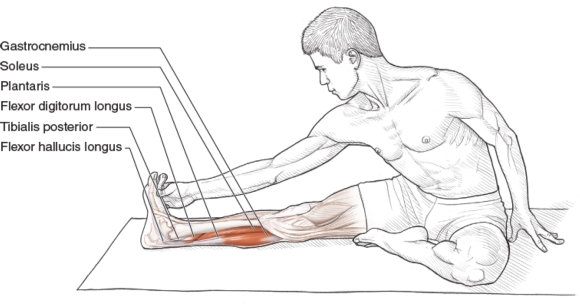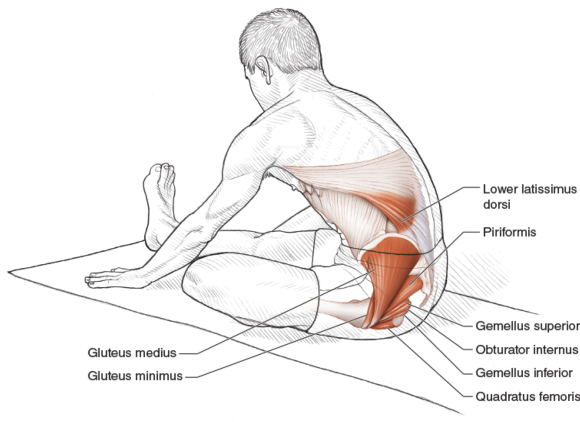Intermediate seated hip external rotator and extensor stretch
This is an excerpt from Stretching Anatomy-3rd Edition by Arnold G Nelson,Jouko Kokkonen.
Execution
- Sit with the right leg extended straight out in front. Bend the left knee and place the left foot flat against the right inner thigh as close as possible to the pelvic area. Place the hands on the floor next to the thighs.
- Keeping the trunk straight, bend the trunk forward from the hip joint over toward the right (straight) knee as far as possible until you start feeling a slight stretch (light pain). Keep the right knee down on the floor if possible as you bend over. Reach out with your arms toward the right foot.
- Repeat this stretch for the opposite leg.
Muscles Stretched
Most-stretched muscles on left side: Gluteus medius, gluteus minimus, piriformis, gemellus superior, gemellus inferior, obturator externus, obturator internus, quadratus femoris, erector spinae (iliocostalis, longissimus, spinalis), lower latissimus dorsi
Most-stretched muscles on right side: Hamstring (semitendinosus, semimembranosus, biceps femoris), gluteus maximus, gastrocnemius
Less-stretched muscles on the right side: Soleus, plantaris
Stretch Notes
The hip external rotator muscles are commonly neglected in stretching routines. Overuse of these muscles in activities such as basketball, soccer, and hockey can lead to soreness, tightness, and even injuries to this area. In addition, poor flexibility usually leads to lower-quality performance. Participants do a lot of stepping sideways, using a lot of these muscles whenever the hip rotates outward. Using this stretch regularly will build flexibility and strength.
Variation
Intermediate Seated Hip Extensor and External Rotator Stretch
Bending the trunk toward the left knee instead of the right knee reduces the stretch of the most-stretched muscles on the left side of the body and increases the stretch of the most-stretched muscles on the right side of the body. Sitting with the right leg extended straight out in front, bend the left knee and place the left foot flat against the right inner thigh as close as possible to the pelvic area. Bend the trunk over toward the left (bent) knee as far as possible until you start feeling a slight stretch (light pain). Repeat on the opposite leg.

Variation
Intermediate Seated Hip External Rotator, Extensor, Knee Flexor, and Plantar Flexor Stretch
Modify the intermediate seated hip external rotator and extensor stretch to include the soleus, popliteus, flexor digitorum longus, flexor hallucis longus, tibialis posterior, gastrocnemius, and plantaris muscles of the lower leg as a combo stretch. Sitting with the right leg extended straight out in front, flex the left knee and place the left foot against the right inner thigh as close as possible to the pelvic area. Bend the trunk over toward the right (straight) knee as far as possible until you start feeling a slight stretch (light pain). As you bend forward, reach with the right arm, grasp the right foot, and pull the toes slowly toward the knee (dorsiflexed position).

SHOP

Get the latest insights with regular newsletters, plus periodic product information and special insider offers.
JOIN NOW



